Author: Gabe Parker, Galaxy; Translator: Deng Tong, Golden Finance
Foreword
DeSoc, short for "decentralized social network," is a growing crypto space that leverages blockchain technology to establish new standards for sharing ideas and information digitally. Like many applications in the broader cryptocurrency industry, these applications aim to promote the values of data ownership, transparency, and censorship resistance. The birth of blockchain-based social media platforms can be traced back to 2016, when the first blockchain-based DeSoc application, Steemit, was launched on the Steem blockchain.
Unlike traditional social media applications that typically require an email to log in, DeSoc applications use a blockchain wallet’s private key signature to log in. Once logged into a DeSoc application using a blockchain wallet, users can share content, follow other users, and collect digital goods in the form of fungible and non-fungible tokens. Ownership of user data is controlled by the user’s wallet and is typically stored in a decentralized file storage setup, unlike centralized data hosting services such as AWS and Google Cloud used by large social media groups such as Facebook and Twitter. Certain DeSoc applications also offer data portability, giving users a unified experience across various applications without the hassle of creating new profiles. Crucially, the technical architecture of DeSoc applications ensures seamless connectivity between users’ profile data and their blockchain wallets.
This report analyzes on-chain activity of the most popular DeSoc applications from 2021, including Farcaster, Friend.tech, DeSo, and more. The report also delves into the narratives and growth strategies driving the adoption of DeSoc applications, specifically the adoption of Farcaster, a relatively new DeSoc application that accounts for over 30% of all DeSoc-related transaction activity in 2024.
Active Users
In 2016, the first DeSoc application called Steemit launched on their own blockchain. Since then, DeSoc applications have accumulated a total of more than 8.7 million users and facilitated more than 82 million transactions on Ethereum, Optimism, Arbitrum, Polygon, BSC, and other Layer-1 blockchains. As of April 6, 2024, the total number of monthly active users on the DeSoc platform is approximately 550,000. In this case, a user is defined as a unique wallet address that has interacted with the smart contract of a DeSoc application in the past month. For most crypto applications, it is not easy to distinguish between active users and seasonal users. The analysis in this report defines "active users" as users who have interacted with the application's smart contract at least once during the application's lifecycle.
The monthly active users of the top DeSoc applications account for approximately 0.15% of Twitter/X's monthly active user base. It is important to highlight that the two DeSoc apps with the most cumulative users were launched between 2020 and 2021, which gives them a longer user onboarding time than Friend.tech and Farcaster. DeSo, a Layer 1 blockchain launched in June 2021, has the highest number of user registrations among DeSoc apps, with 3 million cumulative users. Cyber Connect, a decentralized social graph that supports all EVM-compatible chains launched in September 2021, has the second-highest number of cumulative DeSoc user registrations, with 1.5 million users interacting with the app since its launch. The top five DeSoc applications account for 85% of total registrations. As of April 6, 2024, DeSo accounts for 32% of the total DeSoc application registration share. Although Farcaster's user surge began in late January 2024, the relatively new DeSoc platform already accounts for 3% of the total DeSoc registrations.
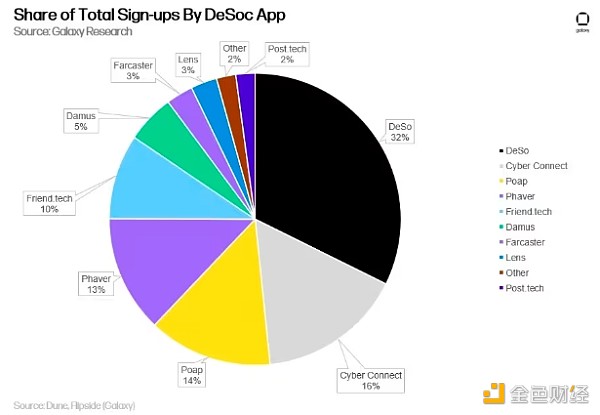
DeSoc apps have different user experiences and focuses. Here is a breakdown of the most popular DeSoc apps by category:
Traditional social media – User experience that includes public posting, commenting, liking, and private messaging.
Social networking – User experience that involves purchasing assets that provide access to gated content (Friend.tech keys) and/or creating partial ownership of social media content (post.tech).
Collect – User experience focused on the collection of digital assets, primarily NFTs.
Other – User experience that does not fall into the three specified categories above.
Traditional social media DeSoc apps are the most used apps in the DeSoc space today, accounting for 67% of total user registrations. This category is a combination of four apps, while the Collection category represents only POAP DeSoc apps. It is worth noting that the social networking space ranks third in terms of user registrations, despite its emergence in August 2023. Although the activity of social networking DeSoc apps such as Friend.tech has declined significantly, their rapid success and ability to compete with the old DeSoc industry are significant.
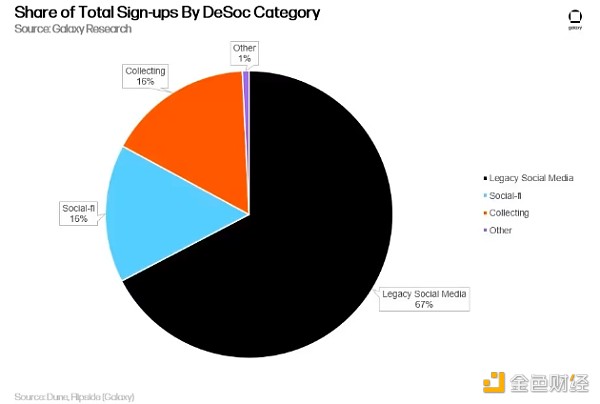
From September 1, 2023 to April 1, 2024, DeSoc added 2.9 million cumulative users, largely due to the launch of Friend.tech, a social network DeSoc application built on the Base Layer-2 (L2) rollup. Friend.tech added more than 800,000 users from August 10, 2023 to January 1, 2024, making a significant contribution to DeSoc's overall user count. Although Friend.tech's success was short-lived, the application clearly triggered a resurgence in other DeSoc applications. After Friend.tech’s user numbers began to stabilize in late October 2023, other DeSoc platforms such as Cyber Connect, Farcaster, POAP, and Lens began to gain new users, as shown in the figure below:
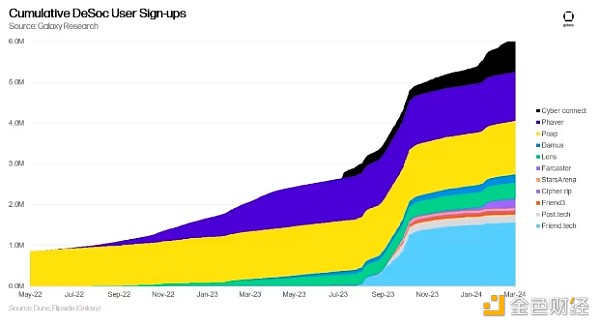
Friend.tech’s explosive growth in 2023 made DeSoc the Web3 comeback of the year. Friend.tech’s user base grew 620x in 3 months, and the app generated over $27 million in revenue. The driving force behind this activity was due to the anticipation of an airdrop of the Friend.tech token. However, as of April 6, 2024, user activity has since declined as there has been no sign of an airdrop from the Friend.tech team. In October 2023, Friend.tech averaged 22,700 daily active users for the month, while by January 2024, this metric has dropped to 1,000.
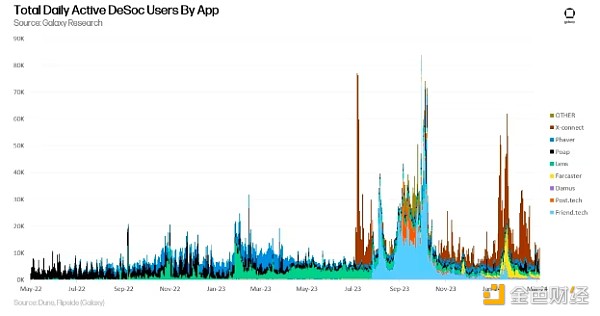
Number of transactions
For users on the DeSoc application to post topics, comment on other users' posts, forward, and complete other operations, they usually need to sign transactions on the chain. Therefore, transactions that interact with the smart contracts of the DeSoc application reflect the usage of the application.
From November 2023 to January 2024, the user transaction activity and the number of daily active users of the DeSoc application experienced a plateau period. DeSoc’s daily trading volume did not start to show promising signs of growth until February 1, 2024, surging an impressive 3x from the previous two weeks. The increase in trading activity can be attributed in part to the resurgence of Farcaster users looking to claim airdrops from sub-communities, also known as channels. Farcaster is a traditional social media DeSoc application on Ethereum L2 Optimism, launched in September 2022. Channels are forums on Farcaster with designated topics. For example, the Bitcoin channel is a place where Farcaster users interested in Bitcoin can share and discuss ideas about Bitcoin. On January 28, 2023, Farcaster’s fastest growing channel, Degen, announced an airdrop of $DEGEN tokens to all channel participants. It is worth noting that the creators of the Degen channel and the token $DEGEN have no relationship with the Farcaster team.
Farcaster’s mid-February 2024 trading volume surge was also driven by the launch of Frames, a new feature that allows users to embed web-based applications in Farcaster posts. With Frames, users can create token minting launchpads, interactive games, and voting polls within Farcaster posts. Building on Farcaster’s momentum, user trading activity on other DeSoc applications, namely Lens and X-Connect, has seen a small resurgence. As of April 6, 2024, Farcaster has facilitated over 6 million daily unique transactions.
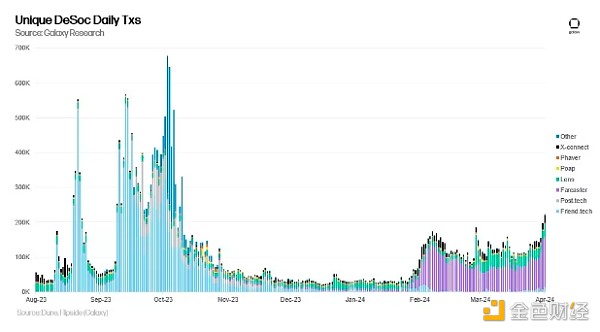
The user growth strategy driven by the opportunity to monetize exclusive access to users and social media content has the highest initial return for DeSoc apps. Friend.tech amassed 820,000 users in 2 months, while Instagram and Twitter took 3 months and 2 years to reach similar levels, respectively. However, DeSoc apps have difficulty retaining users in the medium and long term, with or without financial incentives, as we will discuss in the next section on the DeSoc narrative cycle.
History of DeSoc Narrative Cycles
Historically, peaks in DeSoc activity tend to follow a power law, where one app represents the majority of activity across all DeSoc apps. These boom and bust cycles of DeSoc apps highlight that DeSoc users are not sticky and often jump to the next popular DeSoc app. The last three activity peaks from 2022 to 2024 are telling because they demonstrate that DeSoc activity is driven by cyclical narratives.
The first meaningful peak in DeSoc activity occurred in March 2023, driven primarily by Lens, a traditional social media DeSoc app on Polygon, and X-Connect, another traditional social media app on Binance Smart Chain. At the time, decentralized social media applications that mirrored Web2 social media applications dominated the DeSoc market. The second peak in DeSoc activity in September 2023 was attributed to Friend.tech, which launched a new DeSoc category called “Social-fi”. As mentioned earlier, social networking involves purchasing access to closed content and/or purchasing partial ownership of user content.
The third spike in DeSoc activity in February 2024 was due to a resurgence in user interest in Farcaster. Farcaster’s recent rise represents a resurgence in the decentralized traditional social media movement, which last emerged in March 2023 via Lens and X-Connect.
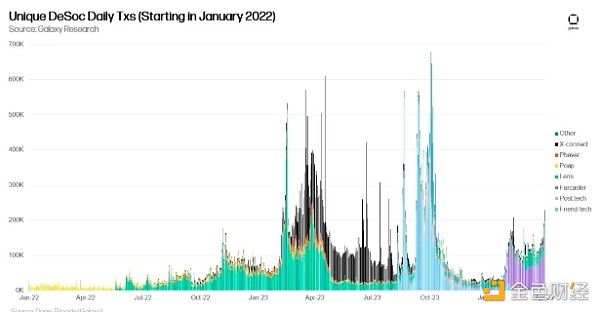
If historical patterns hold, Farcaster’s on-chain activity may decline after 3-4 months, just as past spikes in activity for other leading DeSoc applications have faded. However, Farcaster stands out for its potential to sustain high levels of user activity, as its modular architecture encourages constant innovation from channel creators.
Similar to Lens and X-Connect, Farcaster supports Frames for third-party developers and social media creators to easily build and launch their own DeSoc applications. Existing users of Farcaster can connect to Farcaster-based DeSoc applications without having to create new accounts to try these applications. Additionally, with the introduction of Frames, Farcaster channels and applications outside of the Farcaster ecosystem have increased flexibility in engaging with users by building their own tokens, polls, and interactive games. This programmability enables a curated user experience on Farcaster, which has great potential in driving sustainable user growth and activity for DeSoc.
Conclusion
DeSoc’s trajectory for mass adoption has yet to unfold, but the industry’s resurgence over the past 12 months cannot be ignored. In approximately four years, the user base of DeSoc applications has grown by 8.7 million registrations. Inevitably, as the share of global cryptocurrency holders increases over the next decade, we expect DeSoc users to also increase. Like NFTs, gaming, and DeFi, DeSoc is a sub-sector of the crypto industry that has the potential to drive mainstream adoption of blockchain-based technologies and cryptocurrencies. Looking ahead, Farcaster stands out as a DeSoc application due to its focus on user retention and sustainable growth strategies through creator-led features and content generation.
 JinseFinance
JinseFinance
 JinseFinance
JinseFinance JinseFinance
JinseFinance JinseFinance
JinseFinance JinseFinance
JinseFinance JinseFinance
JinseFinance JinseFinance
JinseFinance JinseFinance
JinseFinance Coinlive
Coinlive  Nell
Nell Bitcoinist
Bitcoinist